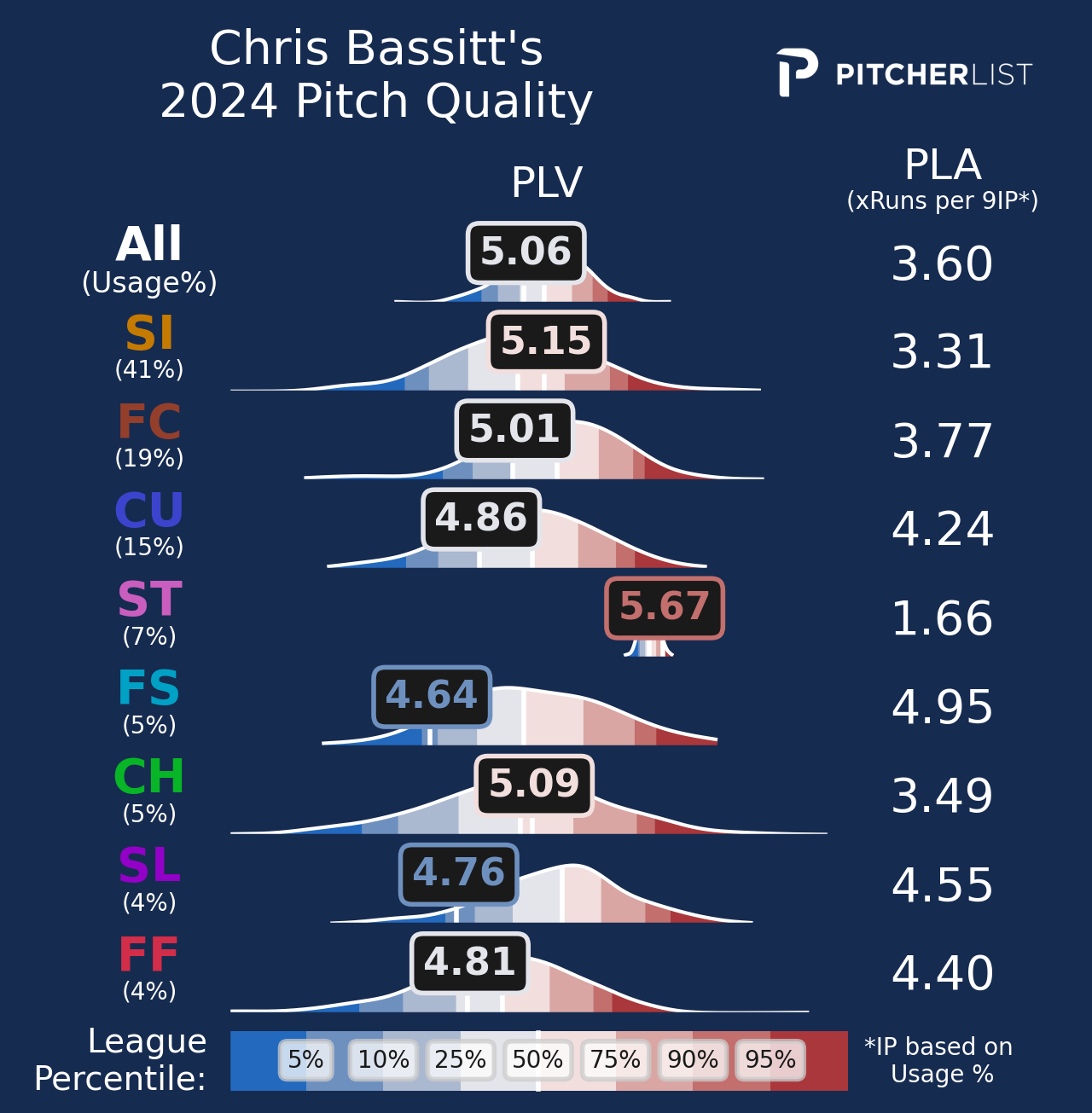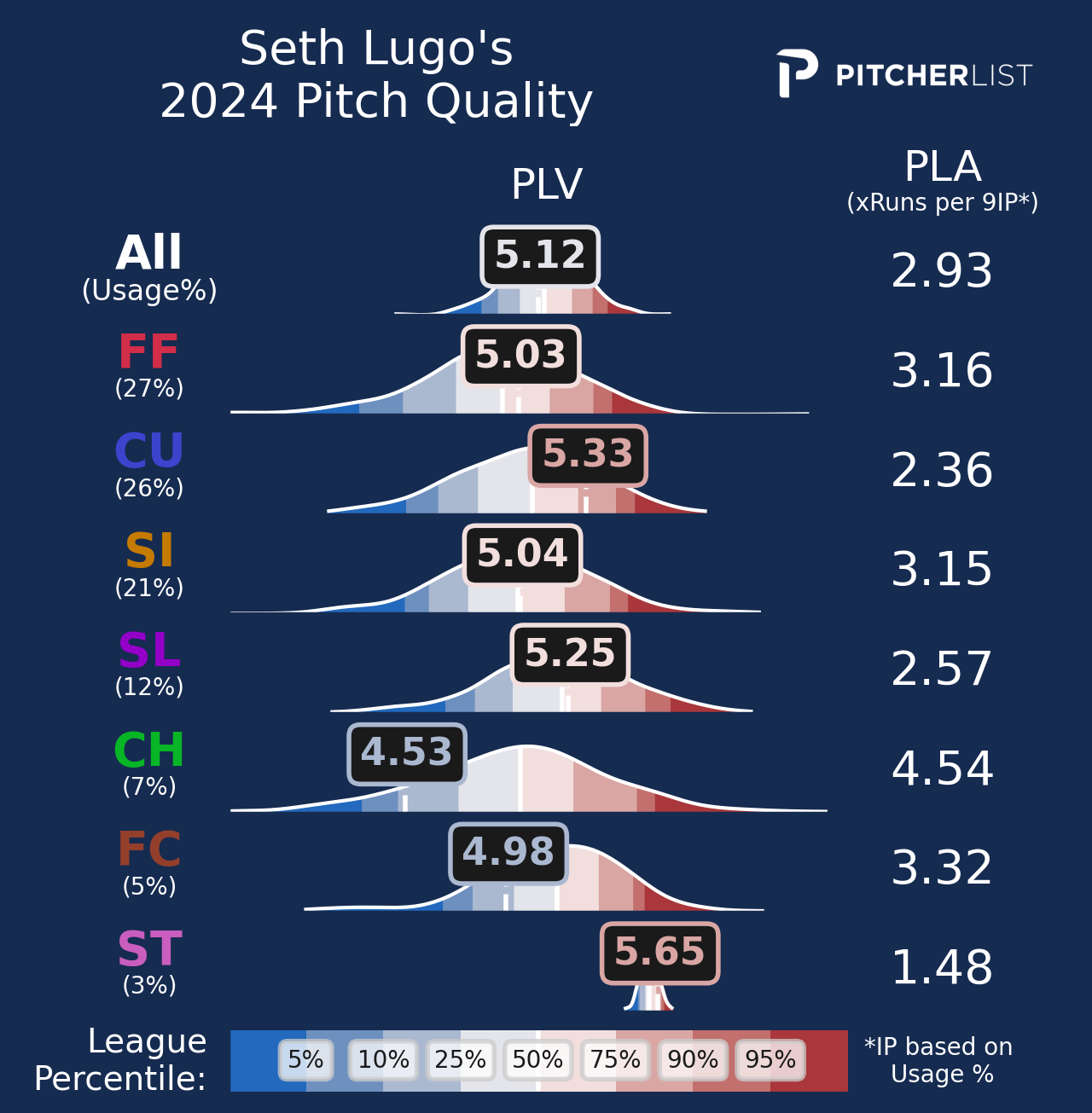Mitch Keller, a 28-year-old starting pitcher for the Pirates, has had an excellent 2024 season thus far, pitching to a 3.11 ERA and 3.48 FIP thus far. In his sixth major league season, Keller has established himself as a staple in an underrated Pirates rotation.
This happened despite a rough start to his major league career; Keller had a 6.02 ERA and 4.30 FIP throughout his first three seasons due to poor command and frequent hard contact.
A top-ranked prospect in the Pirates organization, Keller’s biggest red flag was his pitch arsenal. Despite excellent arm talent that led many scouts to see his future in a major league rotation, Keller often had problems with his pitch shapes, leading him to make many adjustments to his arsenal early in his career.
As Keller’s arsenal developed, so did his results; he missed more bats, induced weaker contact, and got his command under control. Now, Keller is getting excellent results and is well-positioned to stick in the Pirates rotation over the duration of his new 5-year extension.
Keller is not the only pitcher to find more success as his arsenal expanded; pitchers such as Seth Lugo and Chris Bassitt have recently seen success as their arsenals have grown to 7+ pitches.
While it is very difficult to incorporate such a large arsenal of pitches to be consistently used, some pitchers have thrived in recent years. Still, it is worth looking into how they were able to develop, and what steps they took along the way.
How did Keller Do It?
In 2019, after joining the Pirates in the majors, it became nearly instantly clear Keller’s fastball wouldn’t cut it long-term. Batters hit .461 with a .719 SLG against the pitch, and as it was thrown nearly 60 percent of the time, batters did a ton of damage. Even as Keller’s results appeared to improve in 2020, hitters still hit the pitch hard and in the air.
Keller’s secondaries weren’t awful and generated solid results, yet they weren’t enough to get hitters off his four-seam. This trend continued through 2021, where he posted a 6.17 ERA over 100.2 innings and his fastball simply couldn’t miss bats.
Despite seeing minimal changes to his arsenal up until this point in the majors, Keller would enter 2022 with massive changes; not only did his four-seam jump up two ticks in velocity, but he added a sinker, sweeper, and slider while dropping his cutter.
A complete rework of his arsenal, Keller drew both excitement and concern. These were necessary changes, as Keller now had multiple fastballs and breaking balls to generate whiffs in various situations. Still, many were concerned that Keller’s command wouldn’t keep up, as it was already a bit of a problem.
Somehow, Keller’s command got better as his number of pitches increased. While maintaining solid whiffs, Keller walked fewer batters, generated more ground balls, and improved the shape of his four-seam, allowing it to stay his most used pitch.
Keller got solid results from 2022-2023, with his FIP staying around 3.80 over the 353.1 inning sample and earning his first all-star nod in 2023.
In 2024, Keller has taken yet another step forward.

(changeup not shown – 5.29 PLV/104 Stuff+ in 2024 while thrown ~1% of the time)
While his arsenal has been somewhat the same after re-adding a cutter in 2023, Keller has developed 7 pitches to be at least league average. This has led Keller to his best season yet – as he is in year one of his five-year extension with the Pirates, Keller can continue to prove his talent while leading a young Pirates rotation over the next few years.
How did Other Pitchers Do It?
Chris Bassitt is one of the more popular examples of a wider arsenal, firing eight different pitches in 2024 with none being thrown less than 3-4% of the time.

At 35 years old, Bassitt has developed one of the deepest arsenals in the majors. While some of his less frequent pitches have weaker movement profiles, they perform well as a whole, as Bassitt has a 3.52 ERA and 3.74 FIP so far in 2024.
Bassitt never really carried the prospect profile of Mitch Keller; making his big league debut at 25, Bassitt didn’t pitch a somewhat full season until 2019 at age 30, where he performed relatively well. Bassitt had a solid five-pitch mix at the time, where he utilized his excellent command to avoid barrels despite low strikeouts.
As his time in the majors grew, Bassitt’s relatively mediocre stuff was becoming more familiar to the league, leading him to gradually expand his arsenal over the past few years. This has prevented Bassitt from encountering a bad season, as his highest ERA since a 5-game sample in 2016 was 3.60 in 2023.
Seth Lugo is a similar example to Bassitt, as he continues a career-best year in 2024. Lugo has a 2.40 ERA and 3.43 FIP over 97.1 innings so far in 2024, contributing hugely to a Royals team pushing for the AL Central crown.

Lugo has always had an expansive arsenal, but not until 2024 has he seen such excellent results over a pretty solid sample of 97.1 innings, which is second in the AL.
A reliever early in his career, Lugo signed a three-year deal with the Royals this past offseason to reinforce a young Royals rotation. Instead, Lugo has led them to 10 wins while he is on the mound, generating 3.3 bWAR and 2.0 fWAR already.
Lugo’s high spin curveball has always shined, but the majority of his expansive arsenal has performed well since joining the Royals. Even though Lugo has thrown at least 5 pitch types every season he’s been in the majors, Lugo’s 5.13 average PLV is the best he’s had, even though his K% is his lowest since 2017.
To read more about Lugo’s 2024 season and how his decreased strikeouts are affecting his overall numbers, be sure to check out Nick’s video breakdown of Lugo’s 2024 season thus far.
Takeaways
Overall, there are many conclusions to be drawn from these examples. While many pitchers in recent years have succeeded with wide arsenals, many haven’t. Commanding a frequent variety of changing pitch grips is challenging, and without proper preparation and development, more pitches may have the inverse effect.
Still, I believe it has never been more possible to incorporate more pitch types into your arsenals than right now.
While pitch tracking has been around for 10+ years, many organizations have been slow to incorporate such capabilities into their player development for both the majors and minors.
Look at the Pirates with Mitch Keller – they have been notorious in the past for their pitching philosophies being frustratingly stagnant, as they have emphasized low fastballs and high groundballs for years. This hasn’t always worked, as pitchers such as Gerrit Cole and Joe Musgrove saw far greater success outside of Pittsburgh.
However, this has changed in recent years. The Pirates have developed young, talented pitchers such as Jared Jones, Paul Skenes, and now Mitch Keller to have the profile to succeed.
A lot of this has been through drifting away from their traditional philosophies and embracing a pitcher’s unique ability – which, somehow, was only made clearer through the transparency of pitch tracking.
Pitching is a very fluid art – while some pitchers succeed with 7 pitch types, others succeed with only 2 or 3. To succeed as a team, coaches need to be willing to embrace a pitcher’s unique profile and make the best of it. Thankfully, this is something we have already begun to see, and will likely continue over the future of the sport.

